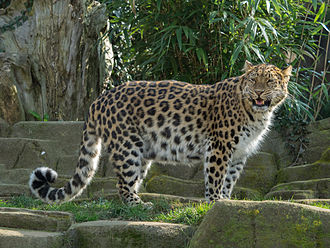The Amur leopard (Panthera pardus orientalis) is a leopard subspecies native to the Primorye region of southeastern Russia and northern China. It is listed as Critically Endangered on the IUCN Red List, as in 2007, only 19–26 wild leopards were estimated to survive in southeastern Russia and northeastern China.[1] It is considered one of the rarest cats on Earth.
The names 'Amurland leopard' and 'Amur leopard' were coined by Pocock in 1930, when he compared leopard specimens in the collection of the Natural History Museum, London. In particular, he referred to a leopard skin from the Amur Bay as 'Amur leopard'. Since at least 1985, this name has been used for the leopard subspecies in eastern Siberia and for the captive population in zoos worldwide.
The Amur leopard is also known as the "Siberian leopard", "Far Eastern leopard", and "Korean leopard".
In 1857, Hermann Schlegel described a leopard skin from Korea under the scientific name Felis orientalis. Since Schlegel's description, several naturalists and curators of natural history museums described zoological specimens of leopards from the Russian Far East and China:
The Amur leopard can easily be differentiated from other leopard subspecies by its thick, pale cream-colored fur, particularly in winter. Rosettes on the flanks are 5 cm × 5 cm (2.0 in × 2.0 in) and widely spaced, up to 2.5 cm (0.98 in), with thick, unbroken rings and darkened centers. Its fur is fairly soft with long and dense hair. The length of hair on the back is 20–25 mm (0.79–0.98 in) in summer and up to 70 mm (2.8 in) in winter. The winter coat varies from fairly light yellow to dense yellowish-red with a golden tinge, or rusty-reddish-yellow. In summer, the fur is brighter, with more vivid coloration pattern. It is rather small in body size, with males larger than females. Males measure 107–136 cm (42–54 in) with a 82–90 cm (32–35 in) long tail, a shoulder height of 64–78 cm (25–31 in), and a weight of 32.2–48 kg (71–106 lb). Females weigh 25–42.5 kg (55–94 lb).
The North Chinese leopard was first described on the basis of a single tanned skin which was fulvous above, and pale beneath, with large, roundish, oblong black spots on the back and limbs, and small black spots on the head. The spots on the back, shoulders and sides formed a ring around a central fulvous spot. The black spots on the nape were elongated, and large ones on the chest formed a necklace. The tail was spotted and had four black rings at the tip.
